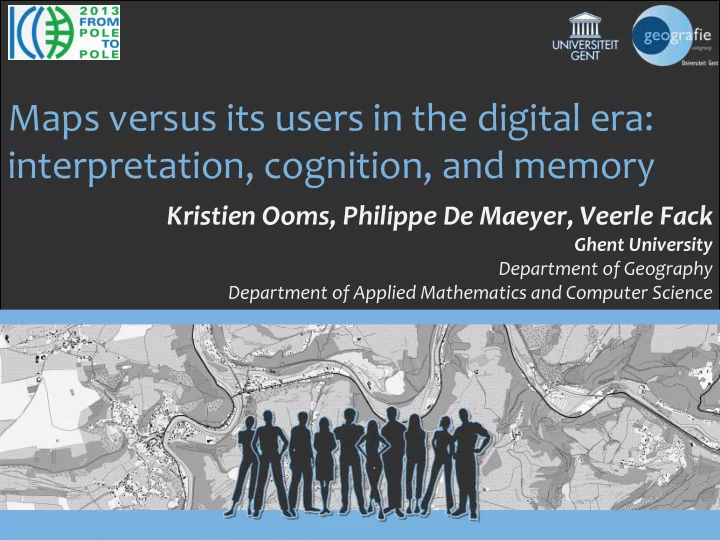

Maps versus its users in the digital era: interpretation, cognition, and memory Kristien Ooms, Philippe De Maeyer, Veerle Fack Ghent University Department of Geography Department of Applied Mathematics and Computer Science
Research Objectives • Communication process: – Cognitive structure Using links, pointers with previous knowledge Transferred Sensory Working Transferred Long Term Sensory Working Long Term Transferred Transferred Input Memory Memory Input Memory Memory Retrieved Retrieved Limited in Virtually ‐ size unlimited ‐ time (debate) – Expertise? – Influence of deviations
Research Objectives Contribute to the understanding of how map users read, interpret, store, and use the presented visual information on screen maps. Understand Understand Interpret Retrieve Attention Read Store Use Improve Improve Influence Influence design design
Stimuli, task, participants, … • Task: – Study (learn) – Draw (retrieve) • Participants: – 12 experts – 12 novices – Gender: balanced
Reading and Interpretation • Eye tracking • Fixations: I nsights in... ‐ At tentive behaviour ‐ Interpretation ‐ Cognitive processes Metrics: ‐ Location of the fixations ‐ Fixation duration ‐ Number of fixations • Saccades:
Reading and Interpretation • Eye movement: – Metrics • Average fixation duration: Experts significantly shorter • Number of fixations per second Experts significantly more Experts Novices ANOVA M SD M SD F P AvgFixDur(s) .308 .046 .339 .062 7.578 .007 Fix/s 2.804 .467 2.566 .469 6.235 .014 TrialDur (s) 335.7 128.0 205.7 128.5 10.516 .002
Reading and Interpretation • Eye movements – Gridded visualisations • Fixation count • Total dwell time • Average fixation duration • Average per user group • Maximum per user group Variable Classification and colour schemes FixCount [0 ‐ 1[ [1 ‐ 2[ [2 ‐ 4[ [4 ‐ 6[ [6 ‐ 8[ [8 ‐ 10[ [10 ‐ 20[ [20 ‐ ...] [.000 ‐ [.325 ‐ [.650 ‐ [1.300 ‐ [1.950 ‐ [2.600 ‐ [3.250 ‐ [6.500 ‐ FixDur .325[ .650[ 1.300[ 1.950[ 2.600[ 3.250[ 6.500[ …......] Colour 255 247 217 189 150 99 37 0 (RGB)
Reading and Interpretation 1. 1. Structuring elements • Eye movements 2. 2. Water bodies!? Insights? 3. 3. Village backgrounds… – 2D gridded visualisations 4. 4. Focus on left side Average fixation count Maximum fixation count
Reading and Interpretation • Eye movements – 3D gridded visualisation Average total dwell time Average fixation duration
Reading and Interpretation • Eye movements – Gridded visualisation: statistical comparison Statistical comparison (ANOVA)
Cognition and Memory • Thinking aloud? – Say out loud every thought – Audio & video recordings – Insights in... • Working Memory Square...rectangle. – How is information stored ..euhm...house? ..what do you guys – How much information think? • Information retrieval – Links with Long Term Memory
Cognition and Memory • Thinking aloud
Cognition and Memory • Thinking aloud – Word segmentation (count in ‰) Based on frequency Based on theme
Cognition and Memory Chapter 6 • Thinking aloud – ‘Full thought’ • 4 Levels of codes: Level 1: Map Level Orientate – Execute ‐ Evaluate Level 2: Item Level Gather Thougts – Draw – Correct ‐ Evaluate Level 3: Confidence Confident – Neutral – Not Confident Level 4: Actions Check – Correct – Draw – Erase – Fill Colour – Talk – Take Pencil • Time ratio for each code: [0 ‐ 1]
Cognition and Memory • Thinking aloud – ‘Full thought’
Cognition and Memory • Sketch maps
Cognition and Memory • Sketch maps – Order of drawing – Scores on maps • Questionnaire – Stated confidence
General Conclusion • Effective screen map design? – Guide attentive behaviour • Reference frame: clearly visible • Other elements: neutral – Structure/organise information • Group objects, e.g. through colour use – Optimal map? • Less essential for non ‐ structuring elements • Important for structuring elements
Thank you for your attention! Questions? Kristien.Ooms@UGent.be
Recommend
More recommend